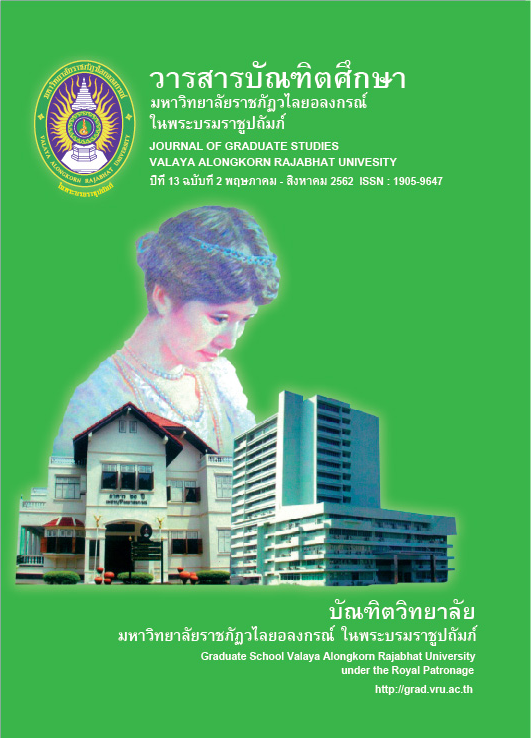THE LEARNING STYLES OF DHURAKIJ PUNDIT UNIVERSITY UNDERGRADUATE STUDENTS
Main Article Content
Abstract
This research aimed to investigate Dhurakij Pundit University’s undergraduate students’ learning styles. The samples were 1501 undergraduate students. The research instruments were the scales measuring the students’ learning styles developed by the researcher. For data analysis, this research employed factor analysis and content analysis.
Based on our analysis of theories and concepts of learning styles, it was found that there are seven different learning styles namely, 1) learning by reasoning, 2) learning by oneself, 3) learning by listening (audio learning), 4) learning from visual stimuli (visual learning), 5) learning in groups, 6) learning from words (verbal learning), and 7) learning by doing. It was found that visual learning had the highest mean; the lowest mean was the learning by oneself. When the students’ learning styles were analyzed, 18 different learning styles were identified, all of which could explain up to 69.97 percent of the total variance of DPU’s undergraduate students’ learning styles. However, when only highest factor loading was determined under the three-variable condition, it was found that only 11 factors satisfied the criteria. The 11 factors are as follows: 1) verbal learning style, 2) visual learning style, 3) inside/outside of class learning style, 4) learning in groups, 5) learning from the environment, 6) learning by doing, and 7) learning through reasoning, 8) learning through listening, 9) learning based on one’s opinion, 10) learning alone, and 11) learning by setting up goals, content, and take action. It was found that the highest factor loading was found to be the factor of verbal learning, and the eleventh factor was learning by setting up goals, content, and then taking action. After the identification of the 11 factors, the researcher asked for advice from the experts and developed the scale for the measurement of the undergraduate students of Dhurakij Pundit University.
Article Details
บทความทุกเรื่องได้รับการตรวจความถูกต้องทางวิชาการโดยผู้ทรงคุณวุฒิ ทรรศนะและข้อคิดเห็นในบทความวารสารบัณฑิตศึกษา มหาวิทยาลัยราชภัฏวไลยอลงกรณ์ ในพระบรมราชูปถัมภ์ มิใช่เป็นทรรศนะและความคิดของผู้จัดทำจึงมิใช่ความรับผิดชอบของบัณฑิตวิทยาลัย มหาวิทยาลัยราชภัฏวไลยอลงกรณ์ ในพระบรมราชูปถัมภ์ กองบรรณาธิการไม่สงวนสิทธิ์การคัดลอก แต่ให้อ้างอิงแหล่งที่มา
References
Gardner, H. (1986). Multiple Intelligences Test based on Howard Gardner’s MI Model.
Grasha, A. and Reichman, S. (1975). Workshop handout on learning styles. Ohio: Faculty Research Center, University of Cincinnati.
Hair, J., Anderson, R., Tatham, R. and Black, W. (1998). Multivariate data analysis. 5th Edition, Prentice Hall, New Jersey.
Kachanchat, J. (2011). satai kān rīan læ saphāwa ʻēkkalak hǣng ton khō̜ng nakrīan chan matthayommasưksā nai čhangwat Nakhō̜n Rātchasīmā [Learning style and Ego Identity Status of High – School Students in Nakhon Ratchasima Province]. Mahasarakham: Mahasarakham University.
Kolb, D. A. (1984). Experiential learning: Experience as the source of learning and Development. Englewood Cliffs, NJ: Prentice-Hall.
Noipitak, S. (2008). kānsưksā khwāmsamphan rawāng rūpbǣp kān rīanrū læ kānraprū khwāmsāmāt khō̜ng tonʻēng nai kān rīan khonʻotsāt kap khwāmsāmāt nai kān khit kǣ panhā thāng khanisāt khō̜ng nakrīan chan matthayommasưksā pī thī sām. [The study of the relationship between learning styles and perceptions their ability to study science and the ability to think and solve problems Mathematics of Mathayom 3 students]. Master’s thesis. Srinakharinwirot University
Panich, W. (2013). kān rīanrū kœ̄t khưn yāngrai [How does learning occur?]. Bangkok: S R Printing Mass Product.
Sinlarat, P. (2006). kānsưksā chœ̄ng sāngsan læ phalit phāp [Creative and Productivity Education]. Bangkok: Chulalongkorn University Printing House.
Sinlarat, P. (2010). kānphatthanā kānsō̜n : tām krō̜p māttrathān khunnawuthi [Teaching development: according to the qualifications standard framework]. Bangkok: Prikwarn Graphic.
Srisa-an, W. (1993). pratyā læ phatthanākān bō̜rihān . nai khana kammakān klum phalit chut wichā lak læ rabop bō̜rihān kānsưksā bannāthikān [Philosophy and Administrative Development]. In the Production Group Committee Major Subjects and Educational Management Systems, (Ed.). ʻēkkasān kānsō̜n chut wichā lak læ læ rabop bō̜rihān kānsưksā nūai thī nưng [Course material Principles and education management system, unit 1]. Bangkok: Sukhothai Thammathirat Open University.


